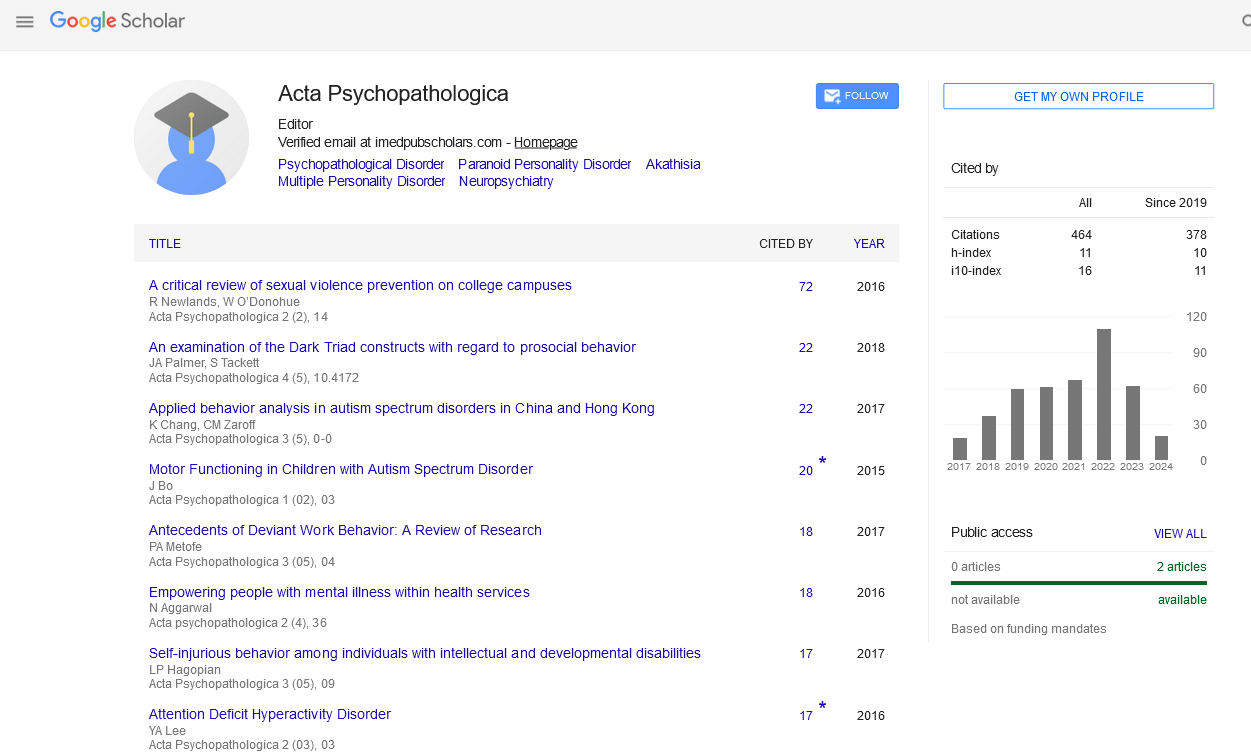Indexed In
- China National Knowledge Infrastructure (CNKI)
- CiteFactor
- Electronic Journals Library
- Directory of Research Journal Indexing (DRJI)
- OCLC- WorldCat
- Publons
- Geneva Foundation for Medical Education and Research
- Google Scholar
- SHERPA ROMEO
- Secret Search Engine Labs
- Serials Union Catalogue (SUNCAT)
Useful Links
Share This Page
Journal Flyer

Open Access Journals
- Agri and Aquaculture
- Biochemistry
- Bioinformatics & Systems Biology
- Business & Management
- Chemistry
- Clinical Sciences
- Engineering
- Food & Nutrition
- General Science
- Genetics & Molecular Biology
- Immunology & Microbiology
- Medical Sciences
- Neuroscience & Psychology
- Nursing & Health Care
- Pharmaceutical Sciences
Opinion - (2024) Volume 10, Issue 5
The Impact of Case Marking on Agreement Attraction in Language Comprehension
Jessica Lan*Received: 01-May-2024, Manuscript No. IPAP-24-20476; Editor assigned: 03-May-2024, Pre QC No. IPAP-24-20476 (PQ); Reviewed: 17-May-2024, QC No. IPAP-24-20476; Revised: 22-May-2024, Manuscript No. IPAP-24-20476 (R); Published: 29-May-2024, DOI: 10.36648/2469-6676-10.05.43
Introduction
Agreement attraction errors in language comprehension occur when elements such as verbs erroneously agree with nearby nouns rather than the correct subject. An example of this is the sentence, the key to the cabinets are on the table, where cabinets wrongly influence the verb is, which should agree with key. Understanding how case marking grammatical markers indicating a nouns syntactic role affects such errors is essential for insights into linguistic processing. Exploring whether robust case marking can mitigate these errors sheds light on fundamental cognitive mechanisms underpinning language comprehension.
Description
One widely utilized therapy technique is Cognitive behavioural Therapy (CBT), which focuses on identifying and challenging maladaptive thoughts, beliefs, and behaviours that contribute to psychological distress. CBT techniques include cognitive restructuring, where clients learn to reframe negative thinking patterns, and behavioural activation, which involves engaging in positive activities to improve mood and motivation. CBT is effective in treating conditions such as depression, anxiety disorders, and post-traumatic stress disorder (PTSD) by teaching clients skills to manage symptoms and improve overall functioning. Another approach is psychodynamic therapy, which explores unconscious conflicts, early childhood experiences, and relationship patterns to gain insight into present-day difficulties. Psychodynamic techniques such as free association, dream analysis, and interpretation of transference help clients explore underlying emotions, motivations, and unresolved conflicts that may contribute to their symptoms. This approach is commonly used in the treatment of personality disorders, trauma-related disorders, and relationship issues. Interpersonal therapy (IPT) focuses on improving interpersonal relationships and addressing interpersonal difficulties that contribute to psychological distress. IPT techniques include communication skills training, role-playing, and exploration of relationship patterns to help clients develop healthier ways of relating to others. IPT is particularly effective in treating mood disorders, eating disorders, and social anxiety by addressing the impact of interpersonal stressors on mental health. Mindfulness-based techniques, such as mindfulness meditation and acceptance and commitment therapy (ACT), emphasize present-moment awareness, acceptance of thoughts and feelings, and valuesbased action. These techniques help clients develop skills for managing stress, regulating emotions, and enhancing overall well-being. Mindfulness-based approaches are beneficial for a wide range of conditions, including chronic pain, addiction, and mood disorders, by promoting self-compassion and resilience. Exposure therapy is a technique commonly used in the treatment of anxiety disorders, phobias, and traumarelated disorders. This approach involves gradual and systematic exposure to feared stimuli or situations to reduce anxiety and desensitize the client’s response. Exposure therapy techniques include imaginal exposure, virtual reality exposure, and in vivo exposure, tailored to the specific phobias or traumatic memories experienced by the client. Family therapy and couples therapy are techniques that focus on improving family dynamics, communication patterns, and interpersonal relationships.
Conclusion
In conclusion, case marking plays a significant role in reducing agreement attraction errors during language comprehension by providing clear syntactic cues about the roles of nouns. Empirical evidence supports the notion that languages with rich case marking systems exhibit fewer such errors compared to those with poor case marking. Nonetheless, the effectiveness of case marking is influenced by factors such as cognitive load, sentence complexity, and the clarity of the markers themselves. Understanding these dynamics is crucial for advancing our knowledge of language processing and the cognitive mechanisms that support it.
Citation: Lan J (2024) The Impact of Case Marking on Agreement Attraction in Language Comprehension. Act Psycho. 10:43.
Copyright: © 2024 Lan J. This is an open-access article distributed under the terms of the Creative Commons Attribution License, which permits unrestricted use, distribution, and reproduction in any medium, provided the original author and SOURCE are credited.

